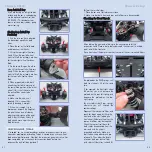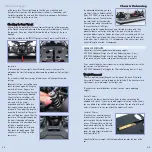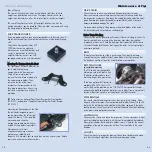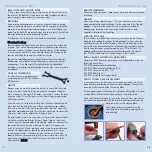
overheat towards the end of a race. Molded inserts are heavier, but they
retain heat better.
The density of an insert has a direct impact on the car’s performance.
•• H
Haarrddeerr ((ddeennsseerr)) iinnsseerrttss:: Less rolling resistance, increased cornering. Firm
inserts are better for quick direction changes, since they'll scrub off less
speed in high-speed chicanes. Inserts that are too hard can cause the car
to be loose.
•• SSoofftteerr ((lleessss ddeennssee)) iinnsseerrttss:: More rolling resistance, more traction. Soft
inserts give a little more grip, and they also make the car easier to slide;
the difference between gripping and slipping (one end sliding out) isn't as
harsh. Soft inserts allow you to 'throw' the car into the corner, and they
probably make the car easier to drive. Inserts that are too soft may cause
your car to wander and be very unstable.
T
Trra
accttiio
on
n C
Co
om
mp
po
ou
un
nd
d
Traction compound (also known as tire conditioner or “traction sauce”), is a
compound that is applied to tires to enhance the performance of the tires.
It softens the rubber and creates more grip.
Before you apply traction compound, it is best to clean the tire surface. Use
a brush to remove any residue or debris on the tires. Then, you can use
motor spray or alcohol on a rag, or commercially-available name-brand tire
cleaners, to clean the tires.
After you clean the tires, apply an appropriate amount of traction compound
to the surface of the tire. If possible, apply at least a half-hour before you run
the car. Wipe off any excess traction compound. This will help soften the tires
and provide you with needed traction.
The best place to use traction compound is on a prepared surface that has
limited traction. Do not use it when you are running on a dirty or dusty
surface (such as a parking lot or in the street in front of your house) because
the tires will become coated with a layer of dust and the car will slide around
even more.
If you are going racing, be sure to ask the racers or the race directors what
type of traction compound is best, or if it is even allowed.
BODY AERODYNAMICS
Aerodynamics play an important role in the performance of the car. One
body may simply work better than another body. Aerodynamic effects are
more apparent at higher speeds, and have less influence in slower corners.
B
Bo
od
diie
ess
Typically, blunt-nosed bodies are more stable, but have less steering than
bodies with a sloped nose. A body with high downforce will provide higher
traction through the turns. However, high downforce usually comes at the
expense of drag, so the car may not be the fastest on a long straightaway.
W
Wiin
ng
gss
Another important consideration in body aerodynamics is the rear wing,
which aids in rear traction. Wings are a vital part of the car’s stability.
Final Adjustments
XRAY shocks can be assembled with non-adjustable or adjustable pistons.
The non-adjustable pistons use a 1-piece piston with 1, 2, 3 or 4 holes in it.
The XRAY adjustable pistons use a unique 2-piece piston assembly that can
be easily adjusted to align 1, 2, 3, or 4 holes.
•• M
Moorree hhoolleess iinn ppiissttoonn:: More oil can pass through the piston as the piston
moves. This means less resistance to shock movement, less damping, and
faster shock movement.
•• FFeew
weerr hhoolleess iinn ppiissttoonn:: Less oil can pass through the piston as the piston
moves. This means more resistance to shock movement, more damping,
and slower shock movement.
We recommend you change both the shock oil weight and number of holes
in the pistons for best effect.
TIRES, WHEELS, and INSERTS
Tires, wheels, and inserts are probably the most important factors in getting
the best performance from your car. Getting them right is the first thing you
should do. All XRAY touring cars accept all popular touring car tires,
including foam tires.
T
Tiirre
ess
When you arrive at the track with a basic car setup, select the best tires and
inserts for your track, then fine-tune your setup. Check with the other racers
who frequent your track for a good starting point.
Here are some general guidelines when choosing tires:
• Use treaded or radial pattern tires on dusty or unprepared surfaces,
and use slicks on high-traction prepared surfaces.
• Select the rubber compound according to the track temperature.
Higher temperatures usually require harder compounds.
• Try using softer tires all around for more traction.
• For more steering or front traction, try softer tires in front than those
in the rear.
Regularly rotate your tires from side to side for even wear. If the same
compound and inserts are used on all four corners, then rotate front to rear
as well.
IIn
nsse
errttss
Rubber touring car tires require tire inserts to retain their shape; typically
these inserts are made from foam or molded foam rubber. Sponge-type
inserts are much lighter, (less rotating mass means quicker acceleration),
but they don't retain heat as well. So it's more likely that the tires will
Final Adjustments
16
15
1 hole open
2 holes open
3 holes open
4 holes open
Summary of Contents for T1R Raycer
Page 1: ......





































